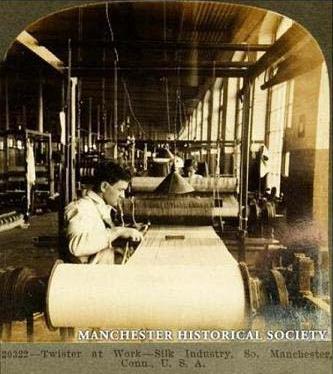



Sometimes the threads from the warp beam are not drawn directly into the harness eyes, as shown in the preceding view of this series. It is often convenient to tie the warp threads to the ends of short lengths of thread already in the harness and then pull the whole warp through the eyes at once. This tying operation is known as twisting.
In this view is seen a twister at work. The two threads to be joined are held in the left hand and their ends are rolled together with the first two fingers and the thumb of the right hand. The man's fingers have first been moistened slightly and coated with chalk and this together with the motion causes the threads to stick together. During this operation, as is readily noticed, the warp beam and harness are placed in the horizontal position and not vertically as is the case when the operation of drawing-in a warp is performed. The warp beam is shown here in the foreground and the harness in the rear.
After the warp threads have been drawn into the harness they are entered or drawn through the reed or comb. This operation is technically known as "sleying." The reed or comb is similar to an ordinary comb but closed at the top and bottom. One or more threads are placed in a dent, that is the space between two teeth of the reed.
For pictures and contemporary information on the Spinning Mill or 'Clock Tower Mill' in the
"Cheney Brothers National Historic Landmark District" page, click here.

 )
)